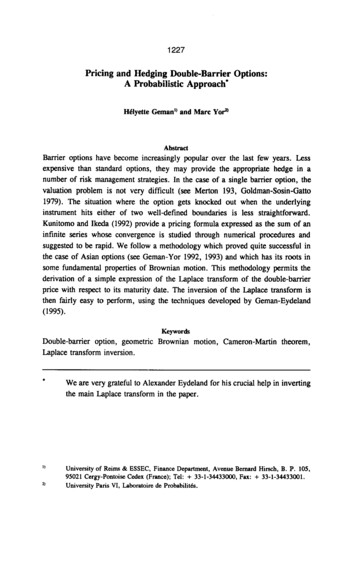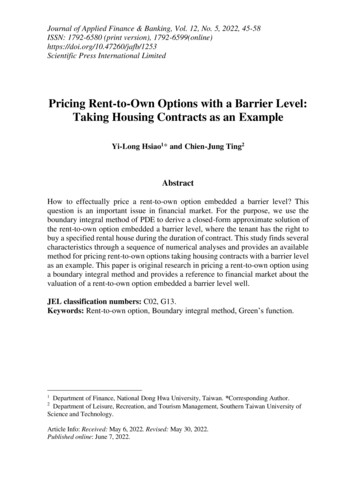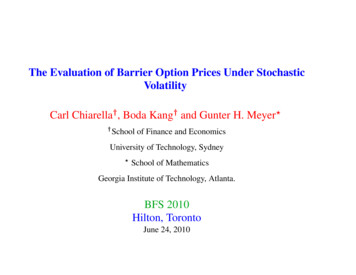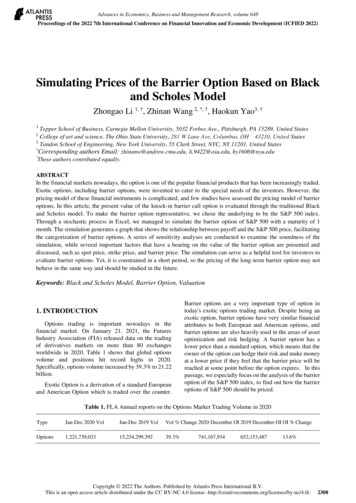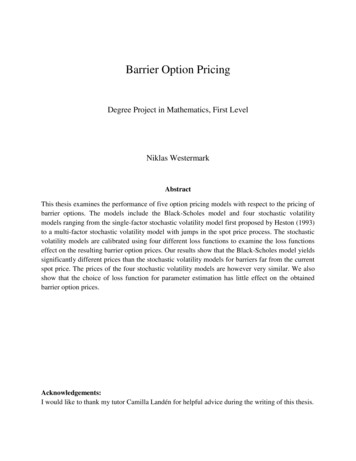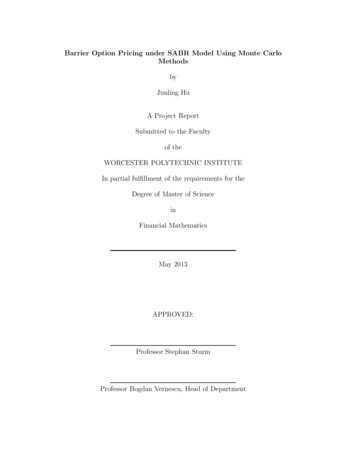
Transcription
Barrier Option Pricing under the2-Hypergeometric Stochastic Volatility ModelRúben Azevedo de to Superior Técnico, Universidade de Lisboa, PortugalJune 2016AbstractThe purpose of this work is to investigate the pricing of financial options under the 2-hypergeometricstochastic volatility model. This is an analytically tractable model which has recently been introducedas an attempt to tackle one of the most serious shortcomings of the famous Black and Scholes optionpricing model: the fact that it does not reproduce the volatility smile and skew effects which arecommonly seen in observed price data from option markets.After a review of the basic theory of option pricing under stochastic volatility, we employ the regularperturbation method from asymptotic analysis of partial differential equations to derive an explicit andeasily computable approximate formula for the pricing of barrier options – one of the most popular typesof exotic options – under the 2-hypergeometric stochastic volatility model. The asymptotic convergenceof the method is proved under appropriate regularity conditions, and a multi-stage method for improvingthe quality of the approximation is also discussed.Keywords: Option pricing theory, Barrier options, Stochastic volatility, Asymptotic analysis, Regular perturbation method.1Introductionstochastic volatility model, which was introducedby Da Fonseca and Martini [1] as a model whichensures that the volatility is strictly positive —this is an important property which is not presentin some other well-established stochastic volatilitymodels. In a very recent paper, Privault and She [2]demonstrated that, under this model, a closed-formasymptotic vanilla option pricing formula can be determined through a regular perturbation method.This is a notable result because their formulas areanalytically very simple, which is rarely the casein models with stochastic volatility: as discussedby Zhu [3], the higher complexity of these modelsusually yields the need for rather sophisticated numerical implementations.Barrier options, which are one of the oldest typesof exotic options, have become increasingly popular in the financial derivative industry because theyallow for much more flexible payoff schemes thanplain vanilla options. It is thus important to construct good barrier option pricing models which areable to reproduce the features observed in real market data.The simplest model for the pricing of financialderivatives is the Black and Scholes model, in whichthe price of all the standard barrier call and put options can be written in closed form. However, it iswidely known that the strong assumptions of thismodel are unrealistic. In particular, the constantvolatility assumption is clearly incompatible withthe so-called smile and skew patters which are generally present in empirical option prices.A natural way to address this significant issue isto introduce randomness in the volatility. For thisreason, option pricing under stochastic volatilityhas been the subject of a great deal of research in recent years. Here we focus on the 2-hypergeometricThe pricing of exotic options under the 2hypergeometric model has to our knowledge neverbeen studied in the literature. Motivated by this,we extend the regular perturbation approach of Privault and She in order to derive an asymptotic pricing formula for barrier-type options. We show that,for a given class of nonconstant barrier functions,an explicit asymptotic formula can be obtained1
and its convergence can be proved with the helpof the Feynman-Kac theorem for Cauchy-Dirichletproblems for parabolic partial differential equations(PDEs). Given that in general our class of barrierfunctions does not include constant functions, thechoice of a nonconstant barrier function which approximates a certain constant barrier level is alsodiscussed.According to Section 3.6 of Jeanblanc et al. [5],the knock-out options defined above can furthermore be classified as regular or reverse barrier options, depending on whether they are out or in themoney when the barrier is reached, respectively.For instance, a down-and-out call option is a regularbarrier option if K H; otherwise, it is a reversebarrier option.23 Barrier option pricing understochastic volatilityWhat is a barrier option?In this subsection we give a very brief introduction to barrier options, where we restrict our attention to the standard knock-out European barrier options which will be addressed in Section 4.A short overview on other important barrier-typeoptions can be found in [4].Standard single-asset barrier options are one ofthe simplest types of the so-called path-dependentoptions. The fundamental distinguishing characteristic between (European) vanilla and barrier optionsis the fact that the payoff of the latter does not depend only on the value of the underlying asset atmaturity, but also on whether the path of the asset’s price touches a given barrier level during thelifetime of the option.Knock-out barrier options become worthless ifthe asset price hits the barrier before maturity. Thetwo standard knock-out barrier call options are:We now present the mathematical formulation ofthe price of a barrier option under a Markovianstochastic volatility model whose dynamics underthe physical measure P are given bydSt µ(t, St )St dt h(Vt )St dWt1dVt a(t, Vt ) dt b(t, Vt ) dWt where S is the asset price process, V is the volatilityprocess, W 1 and W are Brownian motions withcorrelation ρ 6 1, and h is a smooth, positiveand increasing function. For brevity, we skip somedetails, referring the reader to [4].It is worth stressing that, unlike the Black andScholes model, this family of stochastic volatilitymodels is able to reproduce the smile and skew effects in implied volatility structures (see [4] for anintroduction to these concepts).Under standard assumptions on the financialmarket, it is known that stochastic volatility models are incomplete (cf. Definition 2.2 in [4]) and,accordingly, there exist infinitely many risk-neutralmeasures under which arbitrage-free pricing can beperformed. Indeed, if the asset pays no dividendsand the riskless (deterministic and time-dependent)interest rate is r(t), then for any sufficiently regulardeterministic function η(t, x, v) the formulaRT f (η) (t, x, v) e t r(u) du EQ(η) Y St x, Vt v(1)allows us to compute the arbitrage-free price at timet of all contingent claims Y with maturity at futuretime T . Here Q(η) is a risk-neutral measure equivalent to P under which the dynamics of the process(S, V ) are given by The down-and-out call (DOC), whose payoff atmaturity T is(ST K) 1{St Hfor all 0 t T } ,i.e, it has the usual vanilla call payoff if the assetprice process S does not go below the barrier Hduring the lifetime of the option, and it is worthless otherwise; The up-and-out call, whose payoff at maturity is(ST K) 1{St Hfor all 0 t T }meaning that the option becomes worthless if theprice process goes above the barrier.The definition of the two standard knock-out putc1dSt r(t)St dt h(Vt )St dWtoptions is analogous.(2) c dVt a(t, Vt ) b(t, Vt )Λt dt b(t, Vt ) dWtA straightforward generalization of these definitions consists in replacing the constant barrier H where Λt Λ(t, St , Vt ) is defined asby a time-dependent barrier H(t) — such optionsµ(t, St ) r(t) p 1 ρ2 η(t, St , Vt )Λ(t, St , Vt ) : ρare known as time-dependent barrier options.h(Vt )2
c1, Wc are Q(η) -Brownian motions with corand Wttrelation ρ.The process η(t, St , Vt ), which is the so-calledmarket price of volatility risk, cannot be identified within the stochastic volatility model, so itmust be exogenously specified. But, unfortunately,there is no easy criterion for picking the right functional form for η(t, St , Vt ); consequently, a commonpractice is to judiciously choose η(t, St , Vt ) in orderthat the resulting pricing problem is analyticallytractable. (See Section 2.7 of Fouque et al. [6] andSection 10.9 of Lipton [7].)A barrier option with (say) a down barrier isjust a contingent claim Y φ(ST )1{τHt T } wheretτH: inf{u t : Su H}. This means that wecan use Equation (1) for the pricing of barrier options under the stochastic volatility model (2) —this is known as the martingale approach to thepricing problem. Moreover, the barrier option pricef (η) (t, x, v) can also be computed through a PDEapproach: by virtue of the Feynman-Kac theoremfor Cauchy-Dirichlet problems for parabolic PDEs(Theorem 2.8 in [4], which was proved by Rubio in[8]), f (η) is a solution of the two-space-dimensionalterminal and boundary value problem L(η) f (η) (t, x, v) 0,t [0, T ], x H tf (η) (T, x, v) φ(x),x Hf (η) (t, H, v) 0,barrier options will turn out to be very useful forthe derivation of an approximate pricing formula foroptions with constant barriers.4 An asymptotic expansionapproach to barrier option pricingIn this section we will tackle the problem of pricing barrier options under the 2-hypergeometricstochastic volatility — a particular case of the αhypergeometric stochastic volatility model whichwas defined by Da Fonseca and Martini [1] as follows:Definition 4.1. The α-hypergeometric stochasticvolatility model is the Markovian diffusion modelwith dynamicsdSt r(t)St dt eVt St dWt1 cdVt a eαVt dt θ dWt 2(4)where W 1 and W are Brownian motions with correlation ρ, and c, α, θ 0, a R are constants.Like Da Fonseca and Martini [1], we assume thatthe model is given directly under a risk-neutral measure Q. The deterministic function r(t) representsthe (possibly time-dependent) interest rate, whilethe parameters a and c can be used to set the market price of volatility risk.It is important to emphasize that the formulationof the α-hypergeometric stochastic volatility modelgiven by Da Fonseca and Martini [1] and by Privaultand She [2] does not include the drift term r(t)St dt.If, as in these two papers, the goal is to price vanillaoptions, then such a zero interest rate assumptiondoes not entail any loss of generality because, as weshow in [4], the general case of a nonzero interestrate can be reduced to the case r(t) 0 by rewriting the pricing equation in forward terms. However,this argument breaks down when dealing with barrier options, so the model with nonzero drift is theone which must be considered for our barrier optionpricing problem.So as to lighten the notation, we will henceforthassume that the interest rate is constant, i.e, r(t) Rur and therefore t r(s) ds r(u t). Otherwise, itRusuffices to replace the r(u t) terms by t r(s) dsin the forthcoming formulae. We will also assumethat the asset pays no dividends; as discussed in[4], the extension to assets with a continuously paiddeterministic dividend is straightforward.t [0, T ](3)where 2 21 2h (v)x2 2 ρ b(t, v)xh(v)2 x x v1 2 2 b (t, v) 2 r(t)x2 v x r(t) Id. a(t, v) b(t, v)Λ(t, x, v) vL(η) The adaptation of these two pricing approachesto time-dependent barrier options is simple: we justtneed to redefine the stopping time as τH: inf{u t : Su H(u)} and to replace the boundary condition of the PDE problem by f (η) (t, H(t), v) 0.It is also easy to generalize further to the caseof options whose (down) barrier H(t, v) dependsboth on the time and on the (random) volatility:tthe stopping time becomes τH: inf{u t :Su H(u, Vu )} and the boundary condition becomes f (η) (t, H(t, v), v) 0. We will be dealingwith this more general class of barrier options in thenext section because time and volatility-dependent3
with terminal conditions fˆ0 (T, x, v) (x K) andfˆj (T, x, v) 0 for j 1, 2 . . ., and with boundaryOur approach to the barrier option pricing prob- conditions fˆ (t, ĥ(t, v), v) 0 for j 0, 1, 2, . . .jlem is based on a PDE regular perturbation methodWe intend to derive the first-order approximation— known as the small vol of vol asymptotic expan- for the option price and to demonstrate that (undersion — which consists in rewriting the model as a suitable regularity conditions) it converges in theperturbed Black and Scholes model so as to derive following sense:a series expansion of the exact stochastic volatilfˆε (t, x, v) fˆ0 (t, x, v) εfˆ1 (t, x, v) o(ε). (9)ity price around the Black and Scholes price, which4.1The small vol of vol expansionshould converge when the perturbation parametertends to zero. Our first step is thus to take the 2- 4.2 The zero-order termhypergeometric model (4) and replace the constantThe zero-order term fˆ0 (t, x, v) is defined as the soθ by εθ, where ε is a small parameter:lution of the terminal and boundary value problemεεVtε ε1 dSt rSt dt e St dWt (5)εc Lfˆ0 (t, x, v) 0, t [0, T ], x ĥ(t, v)0dVtε a e2Vt dt εθdWt . t2fˆ0 (T, x, v) (x K) ,x ĥ(T, v)(Without loss of generality we will take θ 1.)ˆf0 (t, ĥ(t, v), v) 0,t [0, T ]It is worth pointing out that a somewhat more(10)general approach consists in replacing θ by a genericˆIn other words, f0 is simply the option price correfunction εψ(t, v). As can be seen in [4], the moresponding to the limiting case ε 0. The equivalentgeneral case is handled in essentially the same way.definition of this option price under the martingaleLet ĥ(t, v) be some generic time and volatilitypricing framework isdependent barrier function, to be specified later.hiThe (exact) price fˆε (t, x, v) of the DOC option with fˆ0 (t, x, v) e r(T t) E (STt,v K) 1{τ t T } Stt,v xĥbarrier function ĥ(t, v) under the model (5) is de(11)fined (in the PDE approach) as the solution of the where τ t inf{u t : Sut,v ĥ(u, Vut,v )} andĥterminal and boundary value problem{(Sut,v , Vut,v )}u [t,T ] denotes the diffusion process whose dynamics are given by the noiseless limit ε ˆε L f (t, x, v) 0,t [0, T ], x ĥ(t, v) ε 0 of the model (5). The (degenerate) log tvolatility process Vut,v is therefore the deterministicfˆε (T, x, v) (x K) ,x ĥ(T, v)function of time which solves the ordinary differenfˆε (t, ĥ(t, v), v) 0,t [0, T ] tial equation dVut,v (a c e2Vut,v ) du with initial2(6) condition V t,v v; the explicit solution istwhere c 2v 2a(u t)1t,v 1) .Vu v a(u t) log 1 e (eLε L0 εL1 ε2 L222a c x2 2 e2v 2 rx r Id, In turn, {Sut,v }u [t,T ] is simply a geometric BrowL0 a e2v2 v2 x xnian motion with constant drift r and time 21 2t,vL1 ρxev,L2 .dependent deterministic volatility eVu . x v2 v 2(7)For a given (fixed) initial time t t0 and initialLet us now formally assume that the price log-volatility v v 0 , by recalling the obvious semit0 ,v 0fˆε (t, x, v) can be asymptotically expanded as group property Vut,Vt V t0 ,v0 (t0 t u) we seeufˆε fˆ0 εfˆ1 ε2 fˆ2 . . . Substituting this expan- thatsion into the terminal and boundary value problemt0 ,v 0ˆ(6) and equating the terms of order ε0 , ε1 , ε2 , . . ., f0 (t, x, Vt ) hi0 00 0we obtain the system of PDEs e r(T t) E (STt ,v K) 1{τ t T } Stt ,v xĥ fˆ0 fˆ1 L0 fˆ0 0, L0 fˆ1 L1 fˆ0 0, t t(8) fˆ2ˆˆˆ L0 f2 L1 f1 L2 f0 0, . . . tτĥt0 0Sut ,v0 0ĥ(u, Vut ,v )}.(12)The inf{u t : t0 ,v 0ˆfunction f0 (t, x, Vt ), which only depends on thevariables t and x, is clearly the definition of the pricewhere4
4.3of a DOC option under a Black and Scholes modelwhere the interest rate is r, 0thetime-dependent0Vtt ,vdeterministic volatility is e, t [t0 , T ] and0 0the time-dependent barrier function is ĥ(t, Vtt ,v ),t [t0 , T ].The barrier option pricing problem under theBlack and Scholes model has been studied in theliterature. Rapisarda [9] and Dorfleitner et al. [10]showed that the conditional expectation (12) can bewritten in closed form provided the barrier function0 0ĥ(t, Vtt ,v ), t [t0 , T ] is of the form 0 01 2β 2γ (t, T, Vtt ,v ) (13)H1 exp r(T t) 2 c 2v 2a(u t)where γ 2 (t, u, v) : 1c log 1 2ae (e 1) ,while β R and H1 0 are parameters. Unfortunately, to the best of our knowledge, an explicit0 0expression for fˆ0 (t, x, Vtt ,v ) cannot be obtained un0 0less ĥ(t, Vtt ,v ) has this particular functional form.For this reason, until Subsection 4.4 we will assumethat the barrier function ĥ(t, v) takes the specificform 1 2β 2γ (t, T, v)ĥ(t, v) : H1 exp r(T t) 2(14)in the domain (t, v) [0, T ] R. Given this choice ofbarrier function, Equation (27) of Rapisarda yieldsthe following result:The first-order termThe first-order term solves L0 fˆ1 L1 fˆ0 ,t [0, T ], x ĥ(t, v) tfˆ1 (T, x, v) 0,x ĥ(T, v)fˆ1 (t, ĥ(t, v), v) 0,t [0, T ](16)where the operators L0 and L1 were defined in (7).The first step towards the computation of an explicit expression for the first order term is to givea stochastic representation formula for the solutionof this terminal and boundary value problem:Lemma 4.3. Assume that K H1 . Then the functionfe1 (t, x, v) Z T τ t ĥt,v r(u t)t,vt,vˆ EeL1f0 (u, Su , Vu ) du St xt(17)(where the process (S , V ) and the stopping timeτĥt are defined as in (11)) is the unique classicalsolution of the terminal and boundary value problem(16).t,vt,vProof. The proof of this lemma requires a (nontrivial!) generalization of the Feynman-Kac theoremfor Cauchy-Dirichlet problems for parabolic PDEsˆProposition 4.2. Let f0 (t, x, v) be the zero-order (Theorem 2.8 in [4]) to a setting where the ellipterm in the first-order expansion (9) for the price ticity assumption is not satisfied, as well as otherof a DOC option with barrier function ĥ(t, v) under usual assumptions of Feynman-Kac type theorems.The details are given in [4], pp. 31-34.the model (5). Thenfˆ0 (t, x, v) x N (d1 (t, x, v))Having established this result, the natural courseof action would be for us to compute the expected KeN (d2 (t, x, v)) 2 2βvalue (17) using the joint law of (Sut,v , τĥt ). However,ĥ(t, v) x N (d3 (t, x, v))to the best of our knowledge the analytical expresxsion for the law of (Sut,v , τĥt ) is not available in the 2βĥ(t, v)literature. For this reason, we instead take an al Ke r(T t) N (d4 (t, x, v))xternative approach where we will take advantage of(15)the known results on the Black and Scholes equafor t [0, T ] and x ĥ(t, v), wheretion with time-dependent coefficients so as to derive1the explicit expression for the first-order term.d1 (t, x, v) γ(t, T, v)With this in mind, we fix an initial time t t0 x 1 20 log r(T t) γ (t, T, v) , and an initial log-volatility v v . Then we canK H12writed2 (t, x, v) d1 (t, x, v) γ(t, T, v),0 0fˆ1 (t, x, Vtt ,v ) ĥ(t, v)2 Z T τ td3 (t, x, v) d1 (t, x, v) log,ĥ0 00 0γ(t, T, v)xe r(u t) L1 fˆ0 (u, Sut ,v , Vut ,v ) du E tiĥ(t, v)2t0 ,v 0d4 (t, x, v) d2 (t, x, v) log.S xtγ(t, T, v)x r(T t)5
00000(B)0and fˆ1 (t, x, Vtt ,v ) is the solution of the homogeneous terminal and boundary value problem 0 0 Ltbs,v u(t, x) 0,t [t0, T ], x Ĥ(t) twhere τĥt inf{u t : Sut ,v ĥ(u, Vut ,v )}. Thenext lemma provides the PDE problem associatedto this function of the variables t and x:Lemma 4.4. Assume that K H1 . Then the func0 0u(T, x) 0,x Ĥ(T )tion fˆ1 (t, x, Vtt ,v ) is the unique solution of the ter(A)u(t, Ĥ(t)) fˆ1 (t, Ĥ(t)),t [t0, T ].minal and boundary value problem(20) 0 0 ˆ(A) (t, Ĥ(t)) fˆ(A) (t, Ĥ(t), V t ,v ). The ext0 ,v 00wherefˆt11 Lbs u(t, x) L1 f0 , t [t , T ], x Ĥ(t) tistence and uniqueness of solution for each of theu(T, x) 0,x Ĥ(T ) PDE problems (19) and (20) is assured by Theoremu(t, Ĥ(t)) 0,t [t0 , T ] 1 of Heath and Schweizer [11] and by Theorem 1 of(18) Dorfleitner et al. [10], respectively. Consequently,t0 ,v 0t0 ,v 0ˆˆwhere L1 f0 L1 f0 (t, x, Vt ), Ĥ(t) ĥ(t, Vt ), the difference between these solutions must be equal0 0to the unique solution of (18).and Ltbs,v is the differential operator defined asBy virtue of the Feynman-Kac theorem of Heath x2 2Vtt0 ,v0 2t0 ,v 0and Schweizer (Theorem 1 in [11]), the stochastic rxe r Id.Lbs : 2 x2 xrepresentation formula for the unique solution ofProof. This lemma is an easy consequence of the the terminal value problem (19) is0tThe proofs of Lemmas 4.3 and 4.4 given in [4]only cover the case K H1 , i.e, the case of a regular DOC option. If the DOC option is reverse (thatis, K H1 ), the discontinuity of the payoff makesthe problem more difficult, but it is natural to conjecture that it should be possible to generalize theselemmas to the case of a reverse option through somekind of regularization argument where the reverseoption is approximated by some sequence of optionswith smooth payoffs. Therefore, we will not assumethat K H1 in the subsequent computations, sothat it will also be possible to use our first-orderexpansion for the (approximate) pricing of reverseDOC options.Next, we want to eliminate the nonhomogeneityin the problem (18) so that it becomes possible to0 0obtain an explicit expression for fˆ1 (t, x, Vtt ,v ) usingthe known results on barrier option pricing underthe Black and Scholes model with time-dependentcoefficients. With that in mind, we decompose00t0(A)where the function Eβ (t0 , u, x, v 0 ) can be written(A)in closed form. (The expression of the function Eβcan be found in Proposition 3.8 of [4].)(B)As for the function fˆ1 , formula (A15) in Theorem 1 of Dorfleitner et al. [10] assures that it isgiven byZ1 T r(u t0 ) 2Vut0 ,v0 2(B)Ĥ (u) eefˆ1 (t0 , x, v 0 ) 2 t0 (A)0 0 G Ĥ(u), u, x, t0 ; v 0 fˆ1 (u, Ĥ(u), Vut ,v ) du wwhere G is the (known) Green function associatedto the PDE problem; according to our computationsin page 30 of [4], G 2Ĥ(u), u, x, t0; v 0 30 w2πγ (t , u, v 0 )Ĥ 2 (u)( x1Ĥ(u) logexp 2 0log2γ (t , u, v 0 )xĤ(t0 ) 2 )1 2 000 r(u t ) γ (t , u, v ).20where fˆ1 (t, x, Vtt ,v ) is the solution of the nonhomogeneous problem with no boundary conditions 0 0 Ltbs,v u(t, x) L1 fˆ0 ,t [t0, T ], x R tu(T, x) 0,0Since S t ,v is a geometric Brownian motion, it fol0 0lows that Sut ,v is lognormally distributed for anyu [t0 , T ], and this makes it possible to explicitlycompute the expected value inside the time integral.We can therefore writeZ T(A)(A)fˆ1 (t0 , x, v 0 ) Eβ (t0 , u, x, v 0 ) du(21)(A)(B)fˆ1 (t, x, v) fˆ1 (t, x, v) fˆ1 (t, x, v)(A)0(A)fˆ1 (t, x, Vtt ,v ) Z Thi0 00 00 0 e r(u t) E L1 fˆ0 (u, Sut ,v, Vut ,v ) Stt ,v x du.Feynman-Kac theorem for Cauchy-Dirichlet problems for parabolic PDEs. (See [4], page 27.)x R(19)6
We are thus led to the following explicit expression where Lε is the partial differential operator from(7), and the nonhomogeneity term isfor the first-order term:g2ε g2ε (t, x, v)Proposition 4.5. Let fˆ1 (t, x, v) be the first-order(25) : L2 fˆ0 (t, x, v) L1 εL2 fˆ1 (t, x, v).term in the first-order expansion (9) for the priceof a DOC option with barrier function ĥ(t, v) under This is easily seen to be true by recalling that thethe model (5). Assume that K H1 . Thenfunctions fˆε , fˆ0 and fˆ1 are the unique solutions ofthe terminal and boundary value problems (6), (10)Z T"(A)and (16), respectively.fˆ1 (t, x, v) Eβ (t, u, x, v)Next, we use a stochastic representation formulat todefine a candidate solution fe2ε for the PDE probt,v1 G(Ĥ(u), u, x, t; v) e r(u t) e2Vu Ĥ 2 (u)lem (24):2 w#Z T Z T τ t,ε(A)ĥ Eβ (u, s, Ĥ(u), Vut,v ) ds du eεf2 (t, x, v) : Ee r(u t) g2ε (u, Suε , Vuε ) duuti(22)Stε x, Vtε vfor t [0, T ] and x ĥ(t, v), where Ĥ(u) (26)ĥ(u, Vut,v).t,εεεwhere τĥ : inf{u t : Su ĥ(u, Vu )}. We emεεWe observe that the numerical computation of phasize that the process (S , V ) in (26) follows thethe integral in (22) is much easier than solving nu- 2-hypergeometric model (5) with ε 0; in particuεmerically the associated PDE problem (16) or com- lar, here Vt is a nondeterministic process.We intend to establish a growth estimate for ourputing the expectation (17) via Monte Carlo simueεlation. We additionally recall that if K H1 then, candidate solution f2 . As a preliminary step, let usas discussed above, the integral formula (22) can first obtain an upper bound for the growth of theεalso be used to compute the first-order term of an function g2 defined in (25):(in this case formal) asymptotic expansion for theprice of the option.4.4Lemma 4.6. Assume that K H1 . Then, thefunction g2ε satisfies the following growth condition:for any ε 0, there exist constants C, k 0 suchthat g2ε (t, x, v) C 1 x 2k e2kvProving the convergence of theasymptotic expansionfor all t [0, T ], v R and x ĥ(t, v).Now that we have already derived an explicit expression for our first-order approximation (9), it is Proof. We can obtain an explicit expression for thetime to demonstrate that it converges in the limit function g2ε by differentiating the expressions (15)and (22) of the zero and first-order terms respecε 0.Let us start by looking into the PDE problem tively. After a tedious estimation procedure, thewhich is satisfied by the remainder term of the first- lemma follows. (See Appendix B in [4].)order approximation. For ε 0, we define the remainder term asThe next lemma provides the tool for transforming our growth estimate for g2ε into a growth estimate for the candidate solution fe2ε : i1hfˆ2ε (t, x, v) : 2 fˆε(t, x, v) fˆ0 (t, x, v) εfˆ1 (t, x, v) .ε(23) Lemma 4.7. Let (S ε , V ε ) be the diffusion processεˆThen, f2 satisfies the terminal and boundary value with dynamics (5). Then, for any ε 0, there existproblemconstants C, m 0 (which may depend on k) suchthat εε L u(t, x, v) g2 , t [0, T ], x ĥ(t, v)ε 2k2kVuεεε tE sup Su eSt x, Vt vu(T, x, v) 0,u(t, ĥ(t, v), v) 0,t u Tx ĥ(T, v) C 1 x 2m e2mvt [0, T ].(24) for all t [0, T ], x 0 and v R.7
εTheorem 4.9. Let fˆ0 (t, x, v) and fˆ1 (t, x, v) be, respectively, the zero and first-order term in the firstorder expansion (9) for the price fˆε (t, x, v) of aDOC option with barrier function ĥ(t, v) under themodel (5). Assume that K H1 . Then, there existpositive constants C and m which are independentof ε [0, 1] such that Z uZ1 u 2Vsεˆε (t, x, v) fˆ0 (t, x, v) εfˆ1 (t, x, v)Vsε1εfe dWs .e ds Su x exp r(u t) 2 t t C 1 x 2m e2mv ε2(The full proof is in [4], pp. 36-37).for all t [0, T ], v R and x ĥ(t, v).Proof. The estimate for supt u T e2kVu is obtainedby using Itô’s formula to derive the dynamics ofεZ ε e2V and then estimating the moments ofthe process Z ε through a comparison with a geometric Brownian motion. Then, the estimate for2kcan be derived from the closedsupt u T Suεform expressionLet us now use the results from Lemmas 4.6 and4.7 to derive the desired upper bound on the growth 4.5 Single and multi-stage approximaof the function fe2ε defined in (26): for any ε 0,tions to constant barriersthere exist constants C, m 0 which do not dependRecall that we have been assuming that the nonon (t, x, v) such thatconstant barrier function is of the form (14). Forεe f2 (t, x, v) this reason, we have (in general) not been coverZ Thing the case with greater practical interest, which e r(u t) E g2ε (u, Suε , Vuε ) 1{S ε ĥ(u,V ε )}is that of a barrier option with constant barrier H.uutiNotwithstanding, an approximate pricing formulaStε x, Vtε v dufor an option with constant barrier can be obtainedZ T hif the parameters of (14) are chosen in order thatε 2k2kVuε C11 E (Su ) ethe time and volatility-dependent barrier functionti is as constant as possible.Stε x, Vtε v du Such choice of parameters should take into ac C 1 x 2m e2mvcount the fact that our pricing strategy is based(27)on a small vol of vol expansion which is performedfor all t [0, T ], x 0, v R.0 0around the noiseless limit Vtt ,v of the log-volatilityThe only thing that remains to be proved is thatprocess Vtε . Therefore, if one wishes to compute thethe function fe2ε , which we defined as a candidateprice of the option at time t0 [0, T ] and the inisolution for the PDE problem (24), is indeed itstial log-volatility is equal to v 0 , then the parametersunique solution. In fact, if we prove this, then it0 0H1 and β should be chosen such that ĥ(t, Vtt ,v )will follow that fe2ε equals the remainder term fˆ2εis as close to the constant function H as possidefined in (23), and the estimate (27) will assureble. The simplest choice is H1 H and β suchthe convergence of the first-order expansion. t0 )1that ĥ(t0 , v 0 ) H, i.e. β γ 2r(T(t0 ,T,v 0 ) 2 , but thisLemma 4.8. Assume that K H1 and fix ε 0. choice can be improved by choosing the parametersThen, the function fe2ε (t, x, v) defined in (26) is the in some optimal way (cf. page 3 of Rapisarda [9]).It should be noted that the two cases where theunique solution of the terminal and boundary valuebarrier function (14) can be chosen to be constantproblem (24).are the zero interest rate case (i.e, r 0) and theequals its invariantProof. The key ingredient of the proof is to perform case where the initial volatility 2a02vthe change of variables z e and y x ĥ(t, v). value (i.e, v log c ). Otherwise, the choice0 t )1β γ 2r(T(t0 ,T,v 0 ) 2 yields an approximation whichis quite good for small maturities. For large maturities it is possible to improve the quality of theapproximation through the multi-stage procedurewhich we describe next.The idea of the multi-stage method is to resortto a stepwise PDE approach so as to generalize ourIt is then straightforward to show that the restatedversion of the problem is a consequence of theFeynman-Kac theorem for Cauchy-Dirichlet problems for parabolic PDEs. (See [4], pp. 38-41.)Summarizing, we have established the followingconvergence theorem:8
0γ (Ti 1 ,Ti ,VTi 1We note that the resulting explicit formula for(n) 0ˆf0 (t , x, v 0 ) can actually be written in closed formin terms of the cumulative distribution function ofthe n-dimensional normal distribution. (See Subse
For instance, a down-and-out call option is a regular barrier option if K H; otherwise, it is a reverse barrier option. 3 Barrier option pricing under stochastic volatility We now present the mathematical formulation of the price of a barrier option under a Markovian stochastic volatility model whose dynamics under the physical measure P are .


